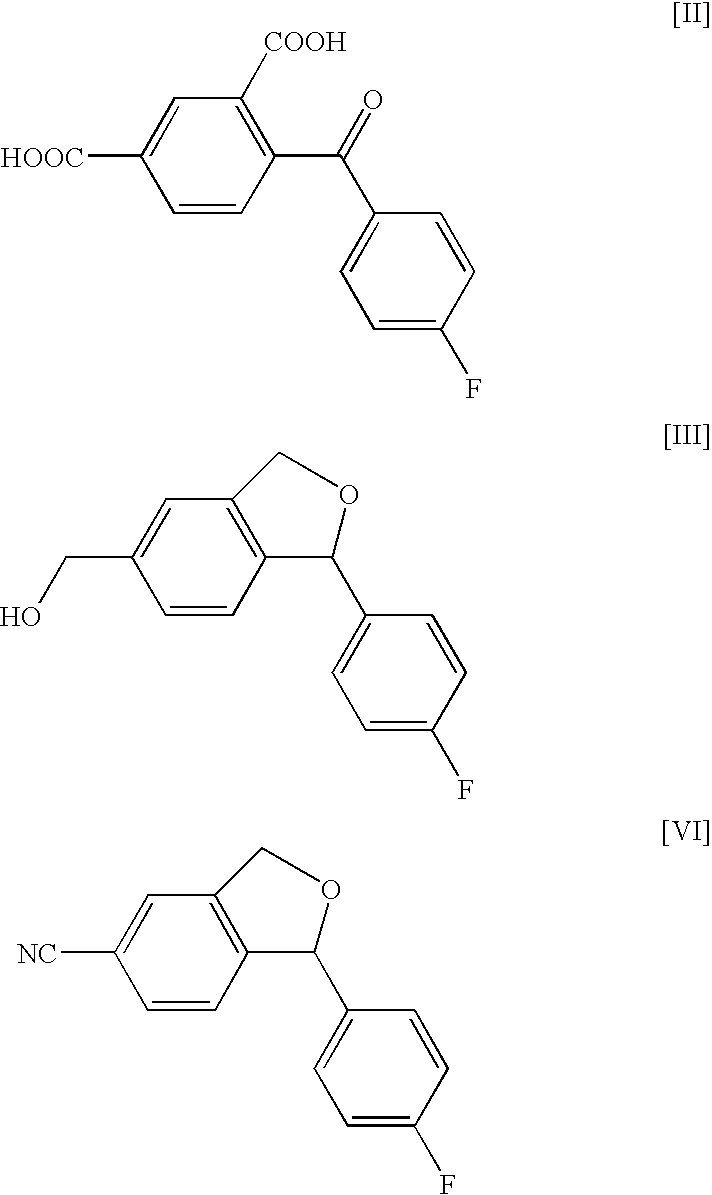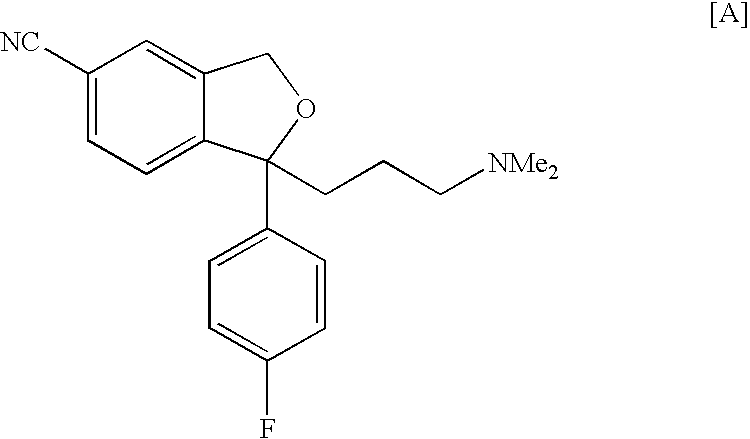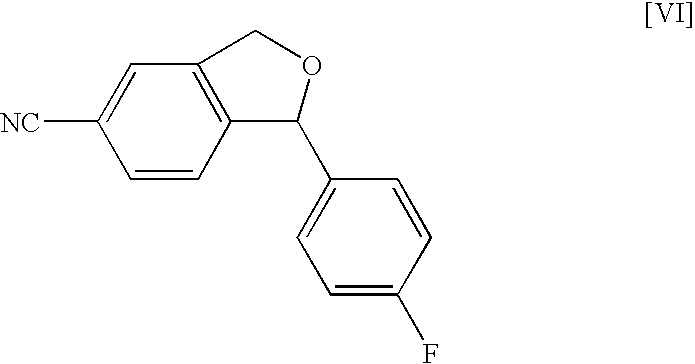Production method of an intermediate for citalopram
a production method and citalopram technology, applied in the preparation of carboxylic compounds, organic chemistry, group 3/13 element organic compounds, etc., can solve the problems of unpreferable method, method industrially unpreferable, and failure to teach how to increase yield
- Summary
- Abstract
- Description
- Claims
- Application Information
AI Technical Summary
Benefits of technology
Problems solved by technology
Method used
Image
Examples
example 1
Synthesis of (2,4-dimethylphenyl)-(4′-fluorophenyl)methanol (compound [I])
[0112]Under a nitrogen atmosphere, turnings of magnesium (16.8 g) were dispersed in THF (116 ml), and iodine (0.1 g) was added. Under a nitrogen atmosphere, a solution of 4-bromofluorobenzene (116 g) in THF (201 ml) was added dropwise at 15-40° C., and the mixture was stirred at 20-40° C. for 2 hr. The obtained mixture with a Grignard reagent was cooled and thereto was added dropwise a solution of 2,4-dimethylbenzaldehyde (81 g) in THF (81 ml) at 0-20° C. After the dropwise addition, the reaction mixture was stirred at 0-20° C. for 2 hr. A saturated aqueous ammonium chloride solution was added to stop the reaction. The reaction mixture was partitioned and the obtained organic layer was retained. The aqueous layer was extracted with toluene and combined with the organic layer obtained earlier, and washed with saturated brine. The solvent was evaporated from the organic layer under reduced pressure to give (2,4-...
example 2
Synthesis of (2,4-dimethylphenyl)-(4′-fluorophenyl)methanol (compound [I])
[0114]Under a nitrogen atmosphere, turnings of magnesium (16.8 g) were dispersed in THF (54 ml), and iodine (0.1 g) was added. Under a nitrogen atmosphere, a solution of 4-bromofluorobenzene (116 g) in THF (201 ml) was added dropwise at 15-40° C., and the mixture was stirred at 20-40° C. for 2 hr. The obtained mixture with a Grignard reagent was cooled and thereto was added dropwise a solution of 2,4-dimethylbenzaldehyde (81 g) in THF (81 ml) at 0-20° C. After the dropwise addition, the reaction mixture was stirred at 0-20° C. for 2 hr. A saturated aqueous ammonium chloride solution was added to stop the reaction. The reaction mixture was partitioned and the obtained organic layer was washed with saturated brine. The solvent was evaporated from the organic layer under reduced pressure to give (2,4-dimethylphenyl)-(4′-fluorophenyl)methanol (139.2 g, 100%) as a colorless oil. The obtained colorless oil was measu...
example 3
Synthesis of (2,4-dimethylphenyl)-(4′-fluorophenyl)methanol (compound [I])
[0115]Under a nitrogen atmosphere, turnings of magnesium (16.8 g) were dispersed in THF (46 ml), and iodine (0.1 g) was added. Then, 4-bromofluorobenzene (2.1 g) was added dropwise. After confirmation of the start of the reaction, THF (242 ml) was flown in. 4-Bromofluorobenzene (113.9 g) was added dropwise at 31.8-48.9° C., and the mixture was stirred at 38-40° C. for 2 hr. The obtained mixture with a Grignard reagent was cooled and thereto was added dropwise 2,4-dimethylbenzaldehyde (81 g) at 5-29.9° C. After the dropwise addition, the reaction mixture was stirred at 21.3-28.3° C. for 1.5 hr. A saturated aqueous ammonium chloride solution was added to stop the reaction. The reaction mixture was partitioned and the obtained organic layer was washed with saturated brine. The solvent was evaporated from the organic layer under reduced pressure to give (2,4-dimethylphenyl)-(4′-fluorophenyl)methanol (139.2 g, 100%...
PUM
 Login to View More
Login to View More Abstract
Description
Claims
Application Information
 Login to View More
Login to View More - R&D
- Intellectual Property
- Life Sciences
- Materials
- Tech Scout
- Unparalleled Data Quality
- Higher Quality Content
- 60% Fewer Hallucinations
Browse by: Latest US Patents, China's latest patents, Technical Efficacy Thesaurus, Application Domain, Technology Topic, Popular Technical Reports.
© 2025 PatSnap. All rights reserved.Legal|Privacy policy|Modern Slavery Act Transparency Statement|Sitemap|About US| Contact US: help@patsnap.com



